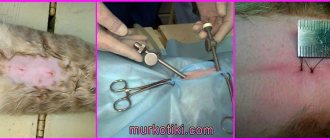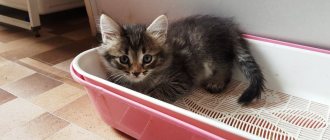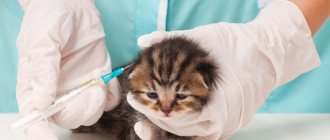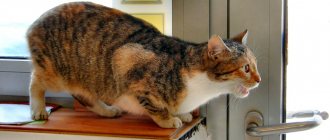When, in how many months or years, should a Scottish cat or an animal of another breed be neutered? Until recently, the optimal age was considered 6-9 months. At this time, the cat has already more or less formed, but has not yet learned what male sexual behavior is and has not begun to mark. In addition, cats that have already experienced the joys of sexual life, even after castration, can retain some elements of sexual behavior, because... the experience of spending time with a cat was imprinted in their memory as pleasant. Therefore, it is advisable to remove the cat’s testicles before the first sexual experience.
If you haven’t done it at 7 months, you can castrate your cat at any other time, but preferably before the age of 5 years. After this age, the risk of complications after surgery and anesthesia increases. If the cat is older, then before the operation he definitely needs to have his heart checked.
There is an alternative point of view about at what age to castrate a Scottish kitten. There is still debate among veterinarians and felinologists. Some say that when Scottish Fold cats are castrated early in childhood (3-4 months), this does not spoil their health at all, but it saves the new owners from many problems. After all, such cats are deprived of their testicles in the nursery. This trend comes from Western veterinary medicine. Other veterinarians and felinologists who adhere to the teachings of the Soviet school are opposed, because They believe that without testicles the kitten will develop worse.
In fact, more than 20 years of history of early US operations and research on the topic suggests that there should be no problem. According to American practice, when Scottish kittens and kittens of other breeds are neutered depends solely on their state of health. If it is normal, then the operation is performed from 8 weeks, that is, from 2 months.
There is no universal answer to the question of when Scottish kittens are neutered. It all depends on the individual characteristics of the body. If the kitten is strong, then early castration can be practiced. If he is weak, underweight, and developing poorly, then it is better to postpone the operation.
How is the operation performed?
In general, castration of cats is a simple procedure, but it is performed under general anesthesia. Thanks to this, the animal does not experience pain both during surgery and later, since the analgesic effect after anesthesia lasts for 10-12 hours, and after this period the tissues begin to tighten and the remaining wounds do not cause discomfort. After castration, Scottish Fold cats are returned to their owners on the same day. Typically the whole process goes like this :
- preparation for surgery - administration of a sedative and relaxant;
- general anesthesia;
- preparation of the surgical site;
- direct removal of the testicles;
- antiseptic treatment;
- administration of antibiotics;
- administration of hemostatic agents;
- withdrawal from anesthesia;
- handing over the animal to the owners with all recommendations for care in the first days.
During the operation, incisions are made on the skin of the scrotum in 2 places and, by applying ligatures (silk clamps) to the spermatic cords, the testicles are removed. Stitches are not always required after surgery.
Castration of Scottish Fold cats can take place a little differently. If you have a cat in the house, you can perform a vasectomy on the cat. During such an intervention, the vas deferens are ligated, rather than the testicles are removed.
In this state, the animal cannot have offspring, but does not lose the ability to mate and protects its territory from encroachment by other cats.
It is not uncommon for breeders who keep cats to resort to such an operation, and the cat is invited for mating. In this case, a sterile male kept in the house fully brings the cats out of estrus, and there is no risk of producing unwanted offspring.
What you need to know when breeding Scots for the first time
Cats
Readiness for the first mating is determined in cats not only when they reach sexual maturity. Considering its delicate characteristics, this breed may show signs of readiness to have offspring as early as 9-10 months, but mating during this period is strictly prohibited. During early pregnancy, a young female may develop serious diseases, and the offspring may even die during childbirth or be born with serious pathologies and abnormalities.
Having reached the age of one and a half years, the cat becomes completely ready for potential mating. The owner only needs to determine the moment of estrus and look for a partner for his cat. But it is necessary to find a truly worthy partner, since estrus in Scottish Straight cats lasts no more than 4-6 days.
Cats
As for Scottish Straight cats, when they reach sexual maturity, they can mate at absolutely any time. They are not at risk of diseases associated with reduced fertility or those that will interfere with their further normal development. Males who have reached the age of 10 months are considered an adult, ready for reproduction.
The peak of increased activity and greatest fertility occurs in males in the spring season. So, the cat begins to behave restlessly, aggressively, begins to call the cat or mark the territory with urine with a characteristic specific smell.
At what age should castration be performed?
It is very important to know exactly at what age to castrate Scottish cats. This question is complex, since surgery that is too early will have a negative impact on the overall development of the Scot, and surgery that is too late may not help cope with the unpleasant habit of cats marking everything around them.
In some cases, you may encounter recommendations from inexperienced veterinarians who are accustomed to working with outbred cats to perform castration at the age of 6 months. This is strictly not recommended. When the testicles are removed early, physical development is disrupted, which creates the possibility of significant deviations in the proportion of the head to the body. Most often, the head turns out to be too small for the body, which makes the Scots cat look somewhat ugly. The indicated age limits also apply to straight-eared (whose ears stand up) Scottish cats.
Castration of Scottish Fold and Straight-eared cats
When to castrate a Scottish cat or any other breed of animal? And at what month should a Scottish kitten be neutered? Until recently, the optimal age for castration was considered to be 6-9 months. At this time, the cat has already more or less formed, but has not yet learned what male sexual behavior is and has not begun to mark. In addition, cats that have already experienced the joys of sexual life, even after castration, can retain some elements of sexual behavior, because... the experience of spending time with a cat was imprinted in their memory as pleasant. Therefore, it is advisable to remove the cat’s testicles before the first sexual experience.
If you haven’t done it at 7 months, you can castrate your cat at any other time, but preferably before the age of 5 years. After this age, the risk of complications after surgery and anesthesia increases. If the cat is older, then before the operation he definitely needs to have his heart checked.
There is an alternative point of view about at what age to castrate a Scottish kitten. There is debate among veterinarians and felinologists about the time at which Scottish cats are castrated. Some say that when Scottish Fold cats are castrated early in childhood (at 3-4 months), this does not spoil their health at all, but it saves the new owners from many problems. After all, such cats are deprived of their testicles in the nursery. This trend comes from Western veterinary medicine. Other veterinarians and felinologists who adhere to the teachings of the Soviet school are opposed, because They believe that without testicles the kitten will develop worse.
In fact, more than 20 years of history of early US operations and research on the topic suggests that there should be no problem. According to American practice, when Scottish kittens and kittens of other breeds are neutered depends solely on their state of health. If it is normal, and the animal has all its vaccinations, then the operation is performed from 8 weeks, that is, from 2 months.
There is no universal answer to the question of when Scottish kittens are neutered. It all depends on the individual characteristics of the body. If the kitten is strong, then early castration can be practiced. If he is weak, underweight, and developing poorly, then the operation will have to be postponed.
Features of caring for a cat after surgery
After sterilization has been carried out, you should carefully monitor your pet in the first 6 days after it . Caring for wounds after surgery is not required, you just need to carefully monitor your pet so that he does not lick them. Despite the fact that complications almost never occur, the possibility of suppuration cannot be completely ruled out (in this case, you need to contact a veterinarian). On the first day, there should be no water available to the animal, as there is a risk that after undergoing anesthesia the cat will faint and drown, falling with its face into the drinking bowl. You can only give him water under supervision.
How does castration affect
You can castrate a Scottish cat without any fears, since the operation, performed by a qualified doctor, does not cause complications and is very easy. After the intervention with the cat, positive changes occur within a month, resulting in the following:
- increased affection;
- great playfulness;
- loss of interest in cats;
- disappearance of the pungent odor of urine;
- stop marking your territory.
If we talk about the negative consequences of castration in Scots cats, then we should highlight the emerging fatness. After removal of the testicles, animals can easily gain excess weight if they are not provided with proper, nutritious nutrition. For this reason, feeding should be coordinated with an experienced physician. You can also refer to the article on feeding Scots.
If the owner does not plan to continue the Scottish Fold family, it is recommended to resort to the castration procedure. The veterinarian will tell you in detail at what age Scottish Fold cats are neutered, what are the features of the procedure and the rules for caring for the animal at the postoperative stage.
Post-castration care for Scottish Folds
The operation on cats of this breed is performed under general anesthesia. The pain that appears upon completion does not relate to the procedure itself, but to the release of anesthesia and the tightening of the incision.
The animal should recover after anesthesia on the floor. During the postoperative period, the cat may make careless, chaotic movements and may fall.
The pet should be placed sideways on a clean sheet. Since upon recovery from anesthesia the body temperature decreases, the cat is covered with a blanket and a heating pad is placed on it. The duration of the exit is 4-6 hours.
The incision needs daily treatment with disinfectants prescribed by the doctor. Scottish Folds sometimes scratch the healing area. If this happens, the cat should be fitted with a special collar.
To avoid picking up an infection from the tray, toilet granules are replaced with torn napkins or paper towels.
Indications for the castration procedure
Indications for castration of Scottish Fold cats are as follows:
- During puberty and after it ends, the male constantly marks his territory, leaving behind an unpleasant, pungent and persistent smell of urine in the corners of the room and on pieces of furniture.
- There is no way to satisfy the animal's sexual needs.
- Owner's reluctance. If matings with females are not planned, the animal must be castrated. This procedure will help make the character of a dissatisfied pet more calm and docile, as well as maintain good health.
Sexual abstinence can lead to extremely negative consequences. In an adult non-castrated animal, the risk of developing oncology, diseases of the genitourinary system, infection, and decreased immunity increases.
In most cases, pets that were not castrated in a timely manner develop diseases such as prostatitis and urethritis. To avoid these consequences, it is recommended to perform castration.
Medical appointments
Castration can also be used for therapeutic purposes. The procedure is performed if the cat has the following diseases:
- mechanical damage to the testicles, the presence of injuries and wounds: open or closed;
- orchitis;
- tumors;
- incontinence;
- diseases of infectious origin;
- funiculitis
In these cases, sterilization is the only method of ridding the pet of pathology and preventing further development and aggravation of the disease.
Behavioral deviations
The owner can figure out when to castrate a pet based on the pet’s changed behavior. A cat who has completed puberty, but whose natural instincts remain unsatisfied, causes a lot of inconvenience to family members.
His behavior changes dramatically for the worse. The animal constantly marks corners, leaving behind a persistent and unbearable smell of urine (it cannot be completely removed even with special means).
The pet is behaving strangely and aggressively. He meows almost non-stop. He becomes fussy in his habits, constantly walks around the house, sleeps little, and loses interest in food and games. The affection towards the owner disappears and does not allow itself to be stroked. Any sudden movement made near an animal awakens aggression in it.
The Scottish Fold cat can damage furniture with its claws, and it can do this in a revealing manner. The longer he remains in a dissatisfied state, the greater changes are observed in his behavior.
When are Scottish cats neutered?
Sterilization of Scottish cats: Scottish Folds, Scottish Straights, Highland Folds and Highland Straights is carried out at the moment of puberty, which greatly affects the further development of the animal. It matters whether the age at which the operation is performed is too early or too late. Veterinarians consider the optimal development of a Scottish cat for sterilization to be approximately 10-12 months, this is due to the fact that:
The young pet has already grown up enough, is hormonally mature, is able to withstand surgery without complications, and can easily tolerate anesthesia. It speeds up the healing process of skin tissue, which reduces the possibility of infections.
At a more mature age, up to 5 years, postoperative complications and a poor reaction to anesthesia may occur during sterilization. Long-term healing of postoperative suture.
If the cat has had sexual intercourse, then after surgery and removal of the ovaries, she will not be able to give birth, but will retain the function of producing hormones from the pituitary gland and will continue to reproduce in estrus.
Experienced breeders and veterinarians know that sterilization extends the life of a cat to 4 years, which can be explained by the fact that during frequent births a cat loses strength and health to bear kittens, and does not have enough time to recover.
It is difficult to select a purebred Scottish pair, when the fold-eared ones mate - Scottish Folds, Highland Folds with the straight-eared ones - Highland Straights, Scottish Straights. Mating with individuals of other breeds is prohibited; it leads to the birth of out-of-breed kittens. Unfortunately, they often fall into the category of stray animals. Their number will help to reduce castration and street cats as well.
The cost of sterilizing Scottish cats is much higher in the central cities of the Russian Federation, and the price also increases when calling a veterinarian to perform the operation at home. This is convenient for the owner, but more for the pet:
- Moving is always stressful for an animal;
- At home, she will more easily survive post-operative anesthesia;
- In a weakened state, you cannot catch an infection.
Table No. 2: Approximate cost of sterilization of cats in different cities of the Russian Federation
Why is a cat sterilized?
Despite the severity of abdominal sterilization surgery for a Scottish cat, most veterinarians advise performing a medical procedure during puberty that will free the animal from emotional suffering during estrus. Sterilization is especially necessary for Scottish fold cats: Scottish Fold, Highland Fold, mating, which are prohibited due to genetic abnormalities.
The use of special medications temporarily helps, but does not relieve the cat from repeated heats when the dissatisfied animal accumulates surges of hormones. A constant increased accumulation of them in the organs can lead to serious diseases and shorten the life of the pet.
Abdominal surgery is performed under anesthesia, but the cat’s young body can handle it and in 10-14 days, with proper care, the wound will heal.
The operation itself, which allows you to sterilize a cat, is called ovariotomy, and involves removing the ovaries. A more modern method is castration, or ovariohysterectomy, in which not only the ovaries are removed, but also the uterus itself.
Pet after sterilization
After laparoscopy, which is considered a more modern operation, minimally invasive, low-traumatic, the recovery period is shortened, small wounds, fastened with self-absorbable threads, heal quickly with minor treatment.
It is important to know! Laparoscopy is performed under general anesthesia using surgical procedures; three 2mm incisions are used to sterilize the cat. The doctor inserts a small camera into the abdominal cavity, looking at the monitor screen, and removes the uterus and ovaries.
Advantages and disadvantages of the operation
Like any surgical intervention, castration has its advantages and disadvantages, which you need to know in advance. The advantages of the operation include the following:
- Prevention of a number of diseases. In castrated individuals, the likelihood of developing cancer, infections and inflammation of the genitourinary system is reduced.
- Increased life expectancy. Studies show that males who have undergone such surgical manipulation live much longer. On average, castration increases life expectancy by 4 years.
- Safety. If a cat has free access to the street and goes there regularly, there is a risk that during the period of active courtship with females, he may enter into clashes with other males. Sometimes such confrontations end in bloody battles. Neutered males, even if they walk outside, will not have any interest in either females or other cats.
- Changing the animal's behavior for the better. Before castration, the pet is aggressive and irritable, but after the procedure it becomes docile and affectionate. He shows a keen interest in various activities and games.
Castration also has some disadvantages:
- After surgery, the animal actively gains weight. This is due to hormonal changes in the body. To avoid obesity, care after castration involves a properly formulated diet and active physical activity.
- The use of anesthesia is fraught with the risk of complications, including death. This is especially true for pets who have diseases of the heart muscle and vascular system.
- Increased attention of the owner to his pet in the postoperative period. If external sutures were applied during surgery, the cat will have to walk around in a special blanket for some time. This causes him inconvenience, so human help will be required.
To make the cat undergo the operation easier, you need to choose the optimal time.
Postoperative care
After the operation in the clinic, the Scottish cat is given to the owner, who is under anesthesia. To provide postoperative care you must:
- transport the animal in a comfortable carrier;
- do not transport an operated cat on public transport, where it can easily pick up an infection;
- at home, allow the pet to freely recover from anesthesia; its duration depends on the drug administered and the cat’s body;
- the cat is placed on the floor, on a warm bedding, which must be changed in time if the cat pees itself;
- If, during the operation, external stitches were placed on the cat’s wounds, then a blanket is put on so that the cat does not reach them with her tongue;
- After the operation, the Scottish woman is not given food. Just put a bowl of water next to it;
- for postoperative constipation, the cat is given a laxative, on the advice of a veterinarian;
- Many people do prescribed intramuscular injections with antibiotics themselves or take their pet to the clinic;
- Wounds are treated with antiseptics twice a day;
- The blanket is removed only after the wounds have completely healed.
Cat food (after surgery)
It is necessary to feed a castrated cat after surgery taking into account his new physiological state, which changes dramatically. He loses interest in cats, and an increased desire for food appears, which is promptly regulated:
- On the first day after the operation, the animal is not fed; it may vomit from the anesthesia; water is placed nearby.
- They think over a diet for natural feeding with an emphasis on protein, fermented milk, ground foods and vegetables.
- With ready-made food, first they give wet food, premium class, designed for neutered cats.
- They feed cats in small portions, do not leave food in bowls, dose the food, and protect the cat from obesity.
- If the kitten is overweight, fasting days are arranged for him.
Cat food (after surgery)
The sterilization operation is difficult for a Scottish cat to tolerate, especially in the first days, until the suture has healed. Subsequently, the cat’s nutrition and behavior will be affected by hormonal imbalances in the body, increased appetite will appear, and metabolism will deteriorate. The owner must follow the rules:
- On the first day after surgery, while the anesthesia is in effect, the cat is not given food. Make sure she drinks water, otherwise dehydration may occur.
- After the operation, to prevent the stitches from coming apart, the castrated cat is fed light pureed food, preventing constipation from occurring.
- Meals should be fractional, in small portions 5-6 times a day, gradually increasing the daily intake to 150 grams.
- A properly formulated diet should contain -35% protein, 35% carbohydrates and 30% fat.
- After the stitches have healed, you can switch to ready-made super-premium food, specially produced for sterilized cats.
- It is necessary to regularly monitor the weight of the Scottish woman; if she deviates from the norm, she is put on a diet.
Ideal age for castration
The fact of how many months to perform castration plays an important role. If the procedure is carried out while the kitten is still too young, premature surgery may negatively affect its physical development.
If castration is performed on a sexually mature adult cat, his habit of marking territory may continue. It will be almost impossible to rehabilitate the animal.
The age of 10-12 months is considered good for castration. During this period, the cat was almost completely formed physically and psychologically, but had not yet developed the habit of marking territory, because does not experience sexual attraction.
Some owners believe that the optimal age for surgery is 6 months. But this does not apply to all cat breeds. For Scottish Folds this is too early. Carrying out the procedure at 6 months is fraught with disturbances in physical development: the male’s head will become too small in comparison with the body.
What vaccinations are given to kittens, cost
Small, helpless kittens receive the first antibodies that increase immunity along with the mother's cat's milk. After weaning, instead of colostrum, the baby needs additional protection of the body from viruses and bacteria. At the age of 8-10 weeks, vaccinations are required for Scottish kittens. Before the first vaccinations are carried out, the kitten is prepared and the body is prevented from worms.
Depending on the conditions of detention and lifestyle, the first vaccination for a Scot contains:
- a vaccine against herpesvirus, calicivirus, panleukopenia and rabies, even if the animal leads a permanent home lifestyle;
- They also vaccinate against viral leukemia and chlamydia if the kitten lives in a private house, in a country house and leaves the house where it has likely contact with other animals;
Vaccinations for fold-eared kittens, as well as straight-eared Scots, are performed in accordance with the following scheme:
- At 2 months, the full range of vaccinations with the exception of the rabies vaccine;
- At 3 months, revaccination is carried out with the same complex of drugs with the addition of rabies vaccine.
- Every year and beyond, as the child grows, the entire vaccination package is repeated, including the anti-rabies drug.
The cost of vaccination depends on the price of the drug and factors of the procedure in different regions of the country and consists of:
- from the cost of the most common complex of drugs: Purevax RCPCh + Rabizin + Nobivac Rabies;
- prices for issuing a veterinary passport;
- payment for the work of a veterinarian;
- payment for calling a doctor to your home.
Adults (what vaccinations are given to adults + cost)
Vaccinations for adult cats and Scottish cats have the following advantages:
- they support the immunity of animals to environmental living conditions.
- Vaccinated pets develop a persistent, throughout the year, resistance to serious diseases;
- The vaccinated animal is protected itself and the owner is guaranteed protection, for example, from rabies;
- The occurrence of some infectious processes in a mild form
- When walking in nature and interacting with other animals, the risk of your pet contracting an infection is reduced to a minimum.
Throughout life, the vaccination procedure is repeated annually, preferably in the same month of the year. They make sure that the animal is dewormed on time, is healthy, and that the cat is not pregnant or nursing cubs.
The basic composition and cost are similar to vaccination for kittens, depending on the region and other factors.
Features of forced castration in older cats
In older cats, castration is performed extremely rarely, only in exceptional cases if there are medical indications for it. Testicular diseases (tumors, injury, incontinence and a number of other pathologies) are an indication for sterilization of an elderly animal. Also, castration should be resorted to for the following diseases:
- prostatic hyperplasia;
- increased aggression that cannot be corrected;
- diseases and pathologies of the testes.
But you need to understand that such a procedure has a high risk of complications. By old age, many animals develop chronic diseases, which are a contraindication to surgery.
Thus, it is strictly forbidden to resort to surgical intervention in the presence of diseases of the heart muscle and vascular system.
Considering all the risks, castration can only be performed after a thorough examination and a series of tests. The latter include:
- laboratory tests of blood and urine;
- X-ray;
- Ultrasound of internal organs.
In addition, the pet must be examined by a cardiologist. The forced castration operation is performed only by an experienced surgeon. After sterilization, older cats require increased attention and more thorough care. This will help prevent serious complications.
join the discussion
Share with your friends
Many owners are afraid of sterilization or castration of animals. Some people do not see the need for the operation, while others are afraid of the procedure itself. And in vain. After all, medical technologies are developing more and more every year, and the field of veterinary medicine also cannot but boast of new developments. Spaying and neutering cats is a fairly simple operation that can be performed on any four-legged patient. The need for the procedure often arises not only in outbred animals, but also in purebred animals, for example, Scottish fold cats.
Possible risks
In Scottish Fold kittens after castration, the possibility of urethral obstruction cannot be ruled out. Postoperative consequences are also aggravated by an unhealthy pet diet. Excess calcium and phosphorus causes stones in the bladder and kidneys. In addition, fold-eared and straight-eared kittens may experience weight gain after surgery. In order not to increase the risk of various pathologies due to obesity, veterinarians prescribe dietary nutrition to such cats.
Why is the procedure needed?
Castration is necessary for a Scottish cat if the animal constantly marks the territory in the house. As you know, the smell of cat urine has its own characteristics, it is impossible not to notice it, and sometimes even strong alcohol-based detergents cannot cope with this nuisance. If it is not possible to satisfy the cat’s sexual needs, then castration is required . After this procedure, the cats’ urine has a less pungent odor, and the animals stop dirtying interior items and only visit the litter box. The same applies to females. A Scottish girl is unlikely to mark, but the owners will definitely not like the night screams at the door.
If an animal is not offered a sexual partner, then it has a high risk of developing serious diseases, including cancer. In cats in this situation, breast and ovarian cancer is most often detected, and in cats, prostate cancer. Abstinence can also cause other ailments of the genitourinary system: infections, inflammation, urethritis, prostatitis. Many owners solve the problem with the help of hormonal pills, but, in essence, the problem is not solved.
The tablets reduce the desire of animals, but the risk of developing the dangerous diseases listed above does not go away.
Is there an alternative to sterilization?
- No. Unfortunately, no drops or hormonal pills can solve this problem, but only make the situation worse. The drugs cannot neutralize hormones, but only stop estrus, thereby creating a burden on the entire body and harming health. A month will pass, the cat will start walking again, but with much greater force and the duration of the “binge” will increase.
Cats do not experience the joy of motherhood like people, for them it is just an instinct. Childbirth does not help the body in any way; on the contrary, it creates stress and is associated with risk. Allowing a cat to give birth “once for health” is not necessary - this is a myth. And the birth itself and preparation for it is not an easy task. First, you will need to find a purebred Scottish cat, pay its owners a considerable amount for mating, take it to your home for a few days, feed it, care for it, and be responsible for it. If the cat and the cat do not like each other, do not allow a fight and make sure that no one gets injured.
When a cat gives birth, she must attend the birth, recover after it, think about what to do with the kittens, and most importantly, in a few months she will again start yelling, walking and demanding her own.
Advantages and disadvantages
facts will help the owner decide to undergo surgery for his pet .
- As already noted, sterilization and castration of cats significantly reduces the risk of developing serious pathologies of the genitourinary system.
- It has been proven that sterilized cats live longer than those that have given birth. The fact is that during childbirth the animal loses its health and strength, because a cat has to give birth several times a year, and the average life expectancy of Scottish Folds is 10–14 years. Sterilization can prolong a cat's life by 3-4 years.
- The risk of losing your pet is reduced. Now the animal that nature calls outside will not wait near the door for the right moment to escape. This is especially true for residents of upper floors. Often cats, in search of a partner, escape through windows and balconies, and this can be dangerous to their life and health.
- If there is no partner of a suitable breed for a Scottish Fold pet , then you will have to breed the pet with a representative of unsuitable blood. This leads to offspring that have no value. It will be difficult to sell or give away kittens; outbred kittens often end up on the street. Sterilization will reduce the number of stray animals.











